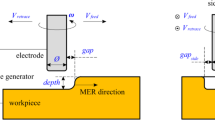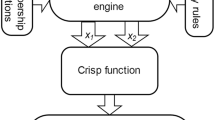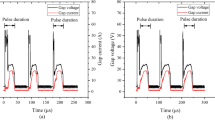Abstract
In order to improve the performance of micro-electrical discharge machining (micro-EDM), the most important issue is to develop a highly stable servo control system. In order to account for the characteristics of high frequency, serious signal distortion, and high noise in micro-EDM process, type-2 fuzzy logic sets are introduced which is able to handle these uncertainties effectively. Based on interval type-2 fuzzy sets theory, a two-stage servo feed controller is designed. The first stage of the controller is for detecting the discharge state for a single sample point, and the second stage is used to obtain the servo feed speed. In addition, the discrimination and statistical methods for discharge states of sample points are proposed to obtain the proportion of each discharge state in an analytical period. Experiments demonstrate that the new controller can obviously improve the processing efficiency of micro-EDM compared with traditional controllers. Therefore, the proposed interval type-2 fuzzy logic-based two-stage servo feed controller is an effective way to enhance the efficiency and stability of micro-EDM and meanwhile to achieve good processing quality.
Similar content being viewed by others
References
Liu K, Lauwers B, Reynaerts D (2010) Process capabilities of micro-EDM and its applications. J Adv Manuf Technol 47(1–4):11–19
Jahan MP, Wong YS, Rahman M (2010) A comparative experimental investigation of deep-hole micro-EDM drilling capability for cemented carbide (WC-Co) against austenitic stainless steel (SUS 304). J Adv Manuf Technol 46(9–12):1145–1160
Han FZ, Wachi S, Kunieda M (2004) Improvement of machining characteristics of micro-EDM using transistor type isopulse generator and servo feed control. Precis Eng 28:378–385
Liao YS, Chang TY, Chuang TJ (2008) An on-line monitoring system for a micro electrical discharge machining (micro-EDM) process. J Micromech Microeng 18(035009):1–8
Hao TG, Li Y, Wang Y (2008) Experimental research on vibration assisted EDM of micro-structures with non-circular cross-section. J Mater Process Technol 208:289–298
Yang XD, Guo JW, Chen XF, Kunieda M (2011) Molecular dynamics simulation of the material removal mechanism in micro-EDM. Precis Eng 35(1):51–57
Zahiruddin M, Kunieda M (2010) Energy distribution ratio into micro EDM electrodes. J Adv Mech Des Syst 4(6):1095–1106
Jahan MP, Saleh T, Rahman M, Wong YS (2010) Development, modeling, and experimental investigation of low frequency workpiece vibration-assisted micro-EDM of tungsten carbide. J Manuf Sci Eng 132(5):1–8, 054503
Koyano T, Kunieda M (2010) Achieving high accuracy and high removal rate in micro-EDM by electrostatic induction feeding method. CIRP Ann-Manuf Techn 59(1):219–222
Zhang LX, Jia ZY, Wang FJ, Liu W (2010) A hybrid model using supporting vector machine and multi-objective genetic algorithm for processing parameters optimization in micro-EDM. J Adv Manuf Technol 51:575–586
Chen PC, Chen CW, Chiang WL (2011) Linear matrix inequality conditions of nonlinear systems by genetic algorithm-based H-infinity adaptive fuzzy sliding mode controller. J Vib Control 17(2):163–173
Chen CW (2011) Stability analysis and robustness design of nonlinear systems: an NN-based approach. Appl Soft Comput 11(2):2735–2742
Chen CW (2010) Modeling and fuzzy PDC control and its application to an oscillatory TLP structure. Math Probl Eng 120403:1–13
Passino M, Yurkovich S (2001) Fuzzy control. Tsinghua University Press, Beijing, pp 99–101
Kao CC, Shih AJ (2008) Fuzzy logic control of microhole electrical discharge machining. J Manuf Sci Eng 130(064502):1–6
Yan MT, Chien HT (2007) Monitoring and control of the micro wire-EDM process. J Mach Tool Manu 47(1):148–157
Byiringiro JB, Ikua BW, Nyakoe GN (2009) Fuzzy logic based controller for micro-electro discharge machining servo systems. IEEE Africon 1–2:175–180
Yan MT, Fang CC (2008) Application of genetic algorithm-based fuzzy logic control in wire transport system of wire-EDM machine. J Mater Process Technol 205:128–137
Wang WY, Cheng CY, Leu YG (2004) An online GA-based output-feedback direct adaptive fuzzy-neural controller for uncertain nonlinear systems. IEEE T Syst Man Cy B 34(1):334–345
Karnik NN, Mendel JM (1998) Introduction to type-2 fuzzy logic systems. In: Fuzzy systems proceedings, IEEE World Congress on Computational Intelligence, The 1998 IEEE International Conference on IEEE Trans, vol 2, pp 915–920
Mendel JM, John RIB (2002) Type-2 fuzzy sets made simple. IEEE Trans Fuzzy Syst 10(2):117–127
Tsung CL, Han LL, Ming JK (2009) Direct adaptive interval type-2 fuzzy control of multivariable nonlinear systems. Eng Appl Artif Intel 22:420–430
Zadeh LA (1975) The concept of a linguistic variable and its application to approximate reasoning-1. J Inform Sci 8:199–249
Mendel JM, John RIB, Liu FL (2006) Interval type-2 fuzzy logic systems made simple. IEEE Trans Fuzzy Syst 14(6):808–821
Uncu Ö, Türksen IB (2007) Discrete interval type 2 fuzzy system models using uncertainty in learning parameters. IEEE Trans Fuzzy Syst 15(1):90–106
Castillo O, Melin P (2008) Type-2 fuzzy logic: theory and applications. Springer, New York, pp 29–30
Karnik NN, Mendel JM (2001) Operations on type-2 fuzzy sets. Fuzzy Set Syst 122:327–348
Liang QL, Mendel JM (2000) Interval type-2 fuzzy logic systems: theory and design. IEEE Trans Fuzzy Syst 8(5):535–550
Choi BI, Rhee FC (2009) Interval type-2 fuzzy membership function generation methods for pattern recognition. Inform Sciences 179:2102–2122
Lin C, Lee CSG (1991) Neural-network-based fuzzy logic control and decision system. IEEE T COMPUT 40(12):1320–1336
Liao QF (2009) Type-II T-S fuzzy modeling and control. Doctoral thesis, Shanghai Jiao Tong University, Shanghai, China, pp 30–31 (in Chinese)
Author information
Authors and Affiliations
Corresponding author
Rights and permissions
About this article
Cite this article
Zhang, L., Jia, Z., Liu, W. et al. A two-stage servo feed controller of micro-EDM based on interval type-2 fuzzy logic. Int J Adv Manuf Technol 59, 633–645 (2012). https://doi.org/10.1007/s00170-011-3535-8
Received:
Accepted:
Published:
Issue Date:
DOI: https://doi.org/10.1007/s00170-011-3535-8




